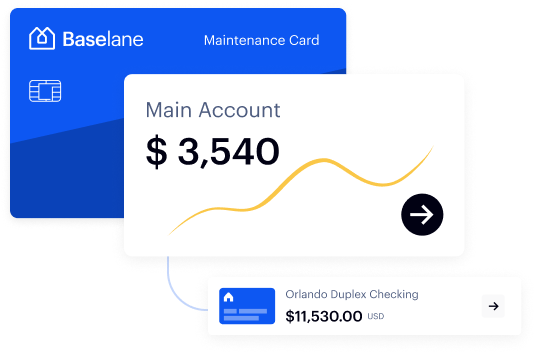As a landlord, there’s nothing more important than collecting rent payments. But having to chase down tenants each month can be a lot of work.
Landlords might be considering asking for the rent on an annual basis as an alternative. But what are the advantages and disadvantages of annual rent collection? And can it help alleviate some of the challenges as a landlord? Or are there better ways to solve rent collection challenges?
Let’s take a look at the pros and cons of monthly vs. annual rent collection, with the short-term and long-term benefits of each.
Put rent collection on auto-pilot
Get paid on time with automated rent payments, reminders, and late fees.
What is Month-to-Month Rent Collection?
Month-to-month rent collection is just as it sounds: collecting rent one month at a time.
Most commonly, landlords collect rent on the first day of the month and collect the rent by check, cash, or using rent collection apps like Baselane.
What is Annual Rent Collection?
Annual rent collection is when the landlord collects rent for an entire year at a time. Rather than paying each month, the tenant pays for the entire 1-year period at the time of signing the lease.
When the year comes to an end, the tenant can choose to prepay for another year, end the tenancy, or possibly negotiate a change to month-to-month.
What are the Advantages of Collecting Rent Month to Month?
Landlords interested in solving challenges with monthly rent collection may find some advantages to this cadence, such as:
- It can be easier to attract a tenant. Residential tenants can seldom afford to put forth an entire year’s rent up-front. People with that amount of cash lying around are far more likely to use it as a down payment on an owned home. Paying rent every month is much more palatable to the vast majority of tenants.
- It reduces churn at the end of the lease. Most of the time, a one-year lease is automatically converted to a month-to-month agreement at the end of the year. When the rent is collected every month, that transition is easier on the tenant making them more likely to stay than if they owe another full year’s rent.
- It keeps a steady flow of cash incoming. While an occasional lump-sum payment might be better, it might also be easier to manage a rental property’s finances with regular payments coming in.
- Increased flexibility on annual rent increases. There may be times when a landlord wants to raise the tenant’s base rent at a time other than the tenant’s anniversary date. With month-to-month rent, landlords have more flexibility when they can raise the rent rather than being locked in for an entire year.
- Tenants can access discounts or bypass credit check requirements. If you want to rent to a specific person who has shaky credit or wants to pay less rent, offering them an annual payment option can be a good way to help them out without taking on added risk.
What are the Disadvantages of Collecting Rent monthly?
Collecting rent in monthly installments also has its disadvantages for both the landlord and the tenant.
- Month-to-month rent makes work. Collecting a rent check and following up on late payments each month can take a lot of work. Fortunately, tools like Baselane’s rent collection automation software can reduce the workload for landlords and tenants when the rent is month-to-month.
- It takes longer for the money to arrive in the bank account. Especially if the tenants are paying by check it can take days for the deposit to post to the account, which can actually reduce the rental property’s profitability. This problem can also be alleviated when automating rent collection.
- The tenant can forget or stop paying the rent. When collecting the rent one month at a time, there are more opportunities for the tenant to pay late or, in the worst-case scenario, not at all.
- It gives the tenant some leverage over the landlord. When landlords collect rent monthly, the tenants can use it as leverage if they’re not happy with things. Even with the recourse available for landlords, unpaid rent hurts the landlord or property manager far more than it hurts the tenant.
What are the Advantages of Collecting Rent Annually?
Collecting rent on an annual basis has its advantages if the landlord can make it happen.
- Receiving more capital upfront. As they say, money now is better than money later. When the rent is paid annually, landlords have more money to work with over the year.
- The tenant can’t walk away. With their entire year’s worth of rent in the landlord’s hands, the tenant is extremely unlikely to want to break the lease.
- There’s less work to do. With the rent prepaid for the year, landlords don’t have to do the work of chasing the tenant’s check each month and don’t have to worry about the clerical work that goes along with late and missing payments.
What are the Disadvantages of Collecting Rent Annually?
While annual rent collection might sound appealing, it does come with its fair share of drawbacks:
- Limited Cash Flow: By collecting rent annually, the landlord will not have a steady income every month. This could pose a challenge, especially if the landlord depends on this regular inflow for maintenance and other property-related costs.
- Higher Financial Risk: If a tenant fails to uphold their end of the annual lease agreement, the landlord will lose significant money. This risk is amplified when the rent is collected annually instead of monthly.
- Less Financial Flexibility for Tenants: Many tenants might find creating an entire year’s rent upfront challenging, potentially limiting your pool of prospective tenants.
- Difficulty Adjusting Rent: It’s easier to increase rent monthly if the market rates go up or rental property taxes or maintenance costs increase. With annual payments, landlords have to wait until the end of the lease period to adjust the rent, which could mean lost income.
Difficulty in Tenant Screening: It could inadvertently attract tenants who can pay upfront but have poor rental histories or credit scores. This might increase the risk of rental property damage or other tenant-related issues.
These disadvantages highlight the importance of having a flexible and reliable rent collection system. Automated rent collection services such as Baselane can offer a suitable solution.
Baselane helps streamline the rent collection process, ensuring timely payments and reducing the stress of monthly collection. While it may not eliminate all the disadvantages associated with annual rent collection, it does provide a more manageable and efficient alternative for landlords.
Our Final Thoughts: Monthly Rent vs. Annual Rent Collection
Collecting the rent annually can sound like a great idea. In theory, landlords get a tenant who’s locked in for an entire year, landlords don’t have to chase their rent check every month, and the job as a landlord becomes a lot easier.
In reality, collecting the rent annually can make things more difficult for the landlord. It may inadvertently attract tenants that wouldn’t otherwise qualify to rent the property, resulting in the landlord having to put up with a sizable liability. They may also themselves be on the wrong side of the law.
A better way to solve some of the challenges of monthly rent collection is to put the rent collection on autopilot.
Rather than manually collecting and cashing a check each month, use automated rent collection software like Baselane that can take the manual effort out of collecting the rent and free up time for more important things.
FAQs about Annual and Monthly Rent Collection
Yes. Whether the landlord collects rent monthly or annually, collecting it online is the best option. Whereas collecting rent via check can be a slow process and prone to security issues, collecting rent online is safe, secure, and fast.
Annual rent collection may appear to have a slight advantage over monthly rent collection for profitability because the landlord can invest the money and collect ahead of time. However, the biggest enemy of rental property profitability is a vacancy, which may actually be more likely if the tenant pays annually.
No matter what rent collection frequency the landlord chooses, Baselane can not only facilitate rent collection but automate it. Landlords can collect rent on the 1st of the month, or the 18th. They can collect for an entire year, or month-to-month. Landlords can also add fees, deposits, and even late fees.
Banking built for real estate
- Multiple accounts per property
- No monthly fees or minimum balances
- Earn up to 4.19% APY2 and up to 5% cash back3



